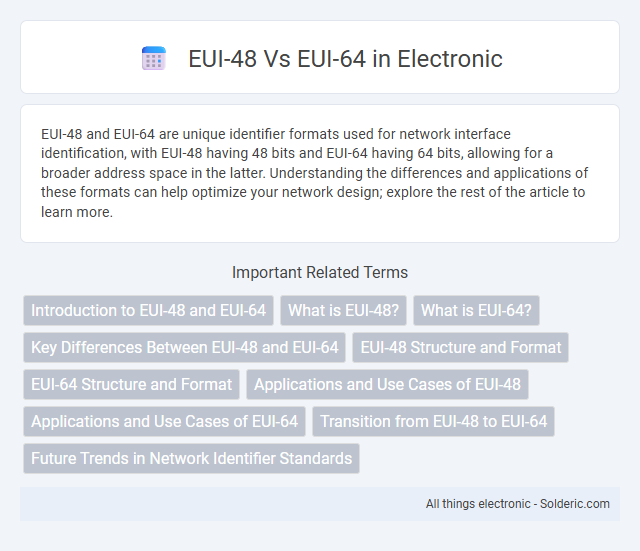EUI-48 and EUI-64 are unique identifier formats used for network interface identification, with EUI-48 having 48 bits and EUI-64 having 64 bits, allowing for a broader address space in the latter. Understanding the differences and applications of these formats can help optimize your network design; explore the rest of the article to learn more.
Comparison Table
| Feature | EUI-48 | EUI-64 |
|---|---|---|
| Address Length | 48 bits | 64 bits |
| Common Usage | MAC addresses for Ethernet, WLAN | IPv6 Interface Identifiers, network devices |
| Format | 6 octets, usually shown as 12 hex digits | 8 octets, shown as 16 hex digits |
| Manufacturer Assignment | Assigned by IEEE OUI (24 bits) | Assigned by IEEE OUI (24 bits) + extended 40 bits |
| Use in IPv6 | Less common, requires conversion | Standard, used for forming interface IDs |
| Address Space | 2^48 (281 trillion unique addresses) | 2^64 (18 quintillion+ unique addresses) |
Introduction to EUI-48 and EUI-64
EUI-48 and EUI-64 are globally unique identifiers used primarily for network interface identification, with EUI-48 consisting of 48 bits (6 bytes) and EUI-64 extending to 64 bits (8 bytes). EUI-48 addresses are commonly used in MAC addresses for Ethernet and Wi-Fi devices, while EUI-64 is utilized in IPv6 addressing to create unique interface identifiers automatically. Understanding the differences in bit length and application allows you to better manage device identification and network segmentation.
What is EUI-48?
EUI-48 is a 48-bit identifier used primarily for network interface cards (NICs) and is synonymous with the traditional MAC address format. It consists of a 24-bit Organizationally Unique Identifier (OUI) assigned by IEEE, followed by a 24-bit device identifier, enabling unique hardware addressing globally. EUI-48 addresses are essential in Ethernet and Wi-Fi technologies for device identification and network communication.
What is EUI-64?
EUI-64 (Extended Unique Identifier-64) is a 64-bit identifier used to assign unique addresses in networking, especially for IPv6 interface identifiers. It extends the EUI-48 format by inserting a fixed 16-bit value (FFFE) in the middle of the original 48-bit MAC address, enabling a broader address space. This method ensures globally unique IPv6 addresses by leveraging the existing MAC address infrastructure for interface identification.
Key Differences Between EUI-48 and EUI-64
EUI-48 and EUI-64 are globally unique identifier formats used for network interface identification, differing primarily in length and address space size; EUI-48 uses 48 bits while EUI-64 uses 64 bits, allowing for a significantly larger address pool in EUI-64. EUI-64 is often employed in IPv6 addressing to create interface identifiers from MAC addresses, enhancing scalability and future-proofing network address allocation. Your network devices may use EUI-48 in traditional Ethernet hardware, but transitioning to EUI-64 supports modern IPv6 environments and improves hierarchical device addressing.
EUI-48 Structure and Format
EUI-48 addresses consist of 48 bits, typically represented as six groups of two hexadecimal digits separated by hyphens or colons (e.g., 00-1A-2B-3C-4D-5E). The first 24 bits comprise the Organizationally Unique Identifier (OUI), assigned by IEEE to identify the manufacturer, while the remaining 24 bits are a unique device identifier allocated by the manufacturer. This structure ensures globally unique identification for hardware interfaces such as MAC addresses in network devices.
EUI-64 Structure and Format
EUI-64 format extends the 48-bit EUI-48 address by inserting a fixed 16-bit value (0xFFFE) in the middle of the original MAC address, creating a unique 64-bit identifier. The structure comprises the original 24-bit Organizationally Unique Identifier (OUI), followed by the 16-bit extension, and then the remaining 24 bits of the MAC address. This format is widely used in IPv6 addressing for interface identifiers, ensuring global uniqueness and compatibility.
Applications and Use Cases of EUI-48
EUI-48 addresses are primarily used in traditional networking environments such as Ethernet MAC addresses, enabling device identification and communication in LANs and WANs. Your network hardware, including switches, routers, and network interface cards, relies on EUI-48 for unique physical addressing to ensure seamless data transmission. This 48-bit address format remains essential for legacy systems and many IoT devices where compact, efficient identification is crucial.
Applications and Use Cases of EUI-64
EUI-64 addressing is essential in IPv6 networks, enabling automatic interface identifier configuration for devices such as routers, servers, and IoT gadgets, ensuring unique and consistent addresses. Unlike EUI-48, which is primarily used for MAC addresses in Ethernet and Wi-Fi, EUI-64 extends the 48-bit MAC to 64 bits, facilitating hierarchical addressing and better scalability in large networks. Your network infrastructure benefits from EUI-64's ability to simplify address autoconfiguration and improve routing efficiency in modern communication systems.
Transition from EUI-48 to EUI-64
The transition from EUI-48 to EUI-64 addresses the growing need for a larger address space to accommodate expanding network demands and IoT device proliferation. EUI-64 extends the 48-bit identifier by adding an additional 16 bits, enabling unique device identification in IPv6 networks and enhancing address auto-configuration capabilities. This shift supports improved scalability, allowing more efficient hierarchical address allocation and reducing address conflicts across diverse and large-scale networking environments.
Future Trends in Network Identifier Standards
EUI-48 and EUI-64 serve as foundational network identifier formats, with EUI-64 gaining traction due to its enhanced address space accommodating IPv6 expansion. Future trends highlight a growing adoption of EUI-64 for improved scalability, security features, and compatibility with next-generation IoT devices. Network standards are evolving to prioritize EUI-64-based identifiers as integral components for seamless device interoperability and automated address configuration in expansive networks.
EUI-48 vs EUI-64 Infographic

 solderic.com
solderic.com